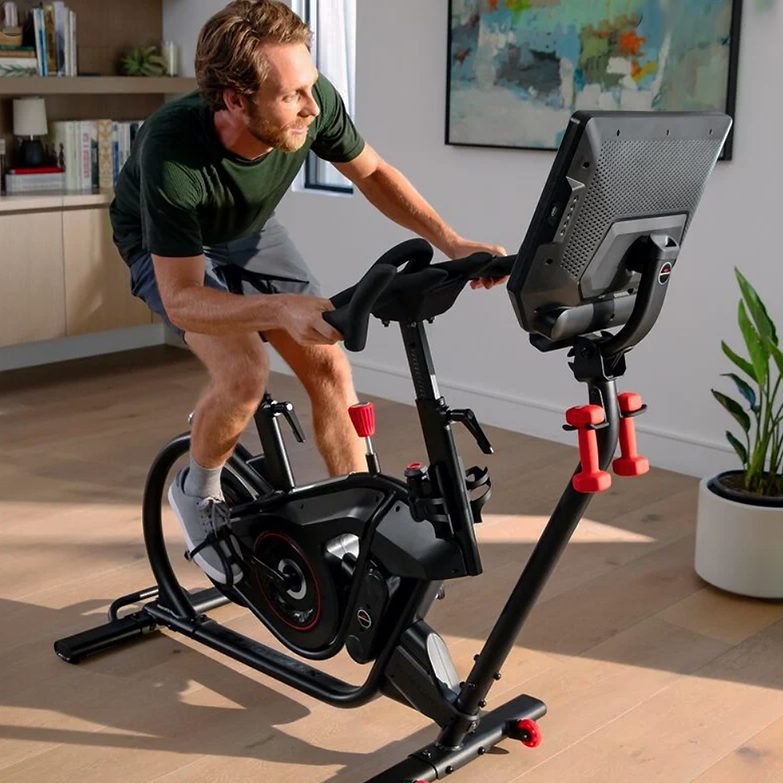Boosted by strong demand for its connected fitness offerings, Nautilus Inc.’s earnings and sales in its first quarter ended June 30 came in well ahead of guidance, but officials warned that higher commodity prices and transportation costs could weigh on margins over the next few quarters.
In the quarter, sales were $184.6 million, up 61.7 percent year-over-year. Sales were ahead 74.4 percent excluding the Octane brand, which was sold in October 2020. On May 10, Nautilus had predicted first-quarter sales would grow between 40 percent and 50 percent versus the prior year or between 51 percent and 62 percent excluding Octane Fitness.
On a conference call with analysts, Jim Barr, CEO, said sales represented the company’s highest June quarter and the fourth highest of any quarter in the company’s 35-year history. The gains were achieved against elevated year-ago sales due to the run-up in demand as the pandemic arrived.
The direct segment grew 26 percent in what’s traditionally Nautilus’ seasonally lightest quarter. The retail segment continued setting records, generating its highest quarterly sales as holiday product starts to ship. Said Barr, “This is an early indicator that our expanded stable of retail partners is betting on a robust fitness and holiday season.”
The company’s international channel recorded its second-highest quarterly sales, up 70 percent or 102 percent excluding Octane.
 Barr said, “Strong sales of our new connected fitness cardio machines, including our VeloCore bikes, combined with solid performance from many of our strength products, including the continued momentum of our SelectTech line, drove these better-than-expected results.”
Barr said, “Strong sales of our new connected fitness cardio machines, including our VeloCore bikes, combined with solid performance from many of our strength products, including the continued momentum of our SelectTech line, drove these better-than-expected results.”
Nautilus said it had reached over 40,000 new customers through its website in the quarter on the appeal of its connected offerings, bringing its new customer count to over 380,000 for the last 15 months. Pre-pandemic, Nautilus’ new customer count averaged about 100,000 a year.
“The growth in direct customers and our expanding retail universe are fueling membership growth for connected product sales,” said Barr. “JRNY membership growth accelerated after we introduced our first embedded screen product in September of 2020. And by the end of June, we had more than doubled the number of members versus the beginning of January.”
Gross Margins Impacted By Chip Shortages And Transportation Costs
Gross margins were affected by higher component costs, including chip shortages and higher commodity prices such as steel, and continuingly elevated transportation costs. Gross margins eroded to 30.1 percent compared to 41.5 percent for the same period last year.
A traditional seasonal shift toward greater direct sales also reduced margins. Direct accounted for 34 percent of sales in this quarter versus 44 percent last year.
Said Barr, “I want to emphasize that we view these margin pressures to be temporary challenges as the world recovers from the disruptions caused by COVID-19. While this impact is significant in the short term, we believe these external margin pressures will normalize over time.”
Despite the gross margin pressures, operating margins improved to 9.7 percent, ahead of guidance between 6.5 percent and 8 percent. The improvement was led by strong top-line results and a strategic decision to shift some investments from its North Star growth strategy from Q1 into Q2, including brand marketing for Tour de France and Olympic advertising.
Operating expenses were $37.6 million, a decrease of 30.9 percent primarily due to the $29.0 million loss related to the sold Octane business. The loss was partially offset by increased selling and marketing expenses, as its direct business returned to more normalized levels of advertising and the company invested in incremental brand marketing. Total advertising expenses were $11.6 million this year versus $2.8 million last year. General and administrative expenses and product development expenses also increased versus last year primarily driven by investments in JRNY.
Operating income came to $17.9 million against a loss of $7.1 million for the same period last year. JRNY investments were $4.6 million this year versus $1 million last year and brand marketing was $3.4 million this year versus $0 last year. Excluding these investments, Q1 2022 operating margins would have been improved by 4 percentage points.
Income from continuing operations improved to $14.0 million, or 43 cents per share, compared to a loss of $5.0 million, or 17 cents, for the same period last year. Net income was $13.9 million, or 43 cents, compared to a net loss of $5.1 million, or 17 cents, for the same period last year.
On an adjusted basis, excluding the impact of the Octane business, operating income was $17.9 million compared to last year’s $21.9 million, driven by lower gross margins, the return to normalized levels of brand marketing and North Star investments. Adjusted income from continuing operations was $14.0 million, or 43 cents per share, down from $16.8 million, or 56 cents, a year ago. Adjusted EBITDA from continuing operations was $21.0 million compared to $25.5 million last year.
Direct Segment Sales Climb 26 Percent
Direct segment sales were $63.4 million, up 25.7 percent. Strength product sales grew 559.4 percent to a historical record, led by the SelectTech weights and Bowflex Home Gyms. Cardio sales declined 31.1 percent, primarily due to end-of-life products that are no longer available for sale this year and a decline in sales of the Schwinn IC4 and Bowflex C6 bikes that was partially offset by VeloCore sales.
As of June 30, Direct’s backlog totaled $3.1 million compared to $26.5 million as of March 31, 2021. These amounts represent unfulfilled consumer orders net of current promotional programs and sales discounts. Direct’s sales results, excluding backlog, were more in line with typical seasonality, with the quarters ending June and ending September representing the lower sales volume quarters.
Gross margins in the Direct segment were 38.7 percent versus 54.6 percent last year. Segment contribution income was $6.8 million or 10.7 percent of sales, compared to $17.0 million or 33.7 percent of sales last year. The decline was primarily driven by lower gross profit and the return to normalized advertising expenditures. Advertising expenses were $8.0 million compared to $2.4 million last year.

Retail Segment Sales Surge 91 Percent
Retail segment sales were $120.5 million, up 91.4 percent year-over-year, and the best quarterly sales in the segment’s history. Growth came to 120.7 percent excluding sales related to the Octane brand. Retail segment sales outside the United States and Canada grew 70 percent or 102 percent excluding Octane.
Strength product sales grew by 119.3 percent, led by its SelectTech weights and benches and Bowflex Home Gyms. Cardio sales increased 83.5 percent, to a historical record, driven by connected-fitness bikes and treadmills.
As of June 30, its Retail segment’s backlog totaled $141.9 million compared to $178.6 million as of March 31, 2021. These amounts represent customer orders for future shipments and are net of contractual rebates and consideration payable to applicable Retail customers.
Gross margins in the Retail segment were 25.1 percent compared to 30.3 percent last year. Segment contribution income was $22.1 million or 18.3 percent of sales, compared to $11.6 million or 18.4 percent of sales for the same period last year, primarily driven by higher gross profit and expense leverage.
Back Half Expected To See Continued Margin Pressures
For the second fiscal quarter, Nautilus expects sales to range between $145 million and $155 million compared with $155.3 million in the year-ago September quarter but representing a two-year revenue CAGR of 53 percent to 59 percent.
Nautilus said that given the distortion caused by the pandemic to selling patterns, it would be measuring business versus last year and versus the same period two years ago for the next few quarters.
Nautilus said that similar to many other companies, external gross margin challenges are expected to continue in Q2 and increased price pressure due to the ongoing chip shortage.
Continued investments in its North Star strategy are planned with encouraging initial results. Brand marketing expenditures in the second quarter will be between $5 million and $6 million versus $3 million last quarter and zero last year. JRNY investment will be between $5.5 million and $6.5 million versus $5 million last quarter and $1 million last year. JRNY investments are expected to further enhance platform functionality via improved adaptive workouts, the addition of a member portal and add fresh content, like the ones provided by its new strategic partner FitOn. These investments are expected to dilute operating margins by 7 to 8 percentage points.
Given these investments and the external macro pressure on gross margin, operating margins are projected to be in the low-single digits.
For the back half of its fiscal year, external macro factors are expected to continue to negatively affect gross margins and operating margins are projected to be in the low- to mid-single-digits. Nautilus reiterated its expectation of reaching 250,000 JRNY members by the end of FY22.
Longer-term, Nautilus reiterated that it believes the near-term external gross margin pressures are temporary and still expects to achieve sustainable operating margins upwards of 15 percent by FYE 2026 as commodity prices stabilize and return closer to pre-pandemic levels and the North Star strategy delivers higher quality recurring revenue as Nautilus shifts from a product-led hardware company to a consumer-led digital company.
Photos courtesy Nautilus, FitOn
















